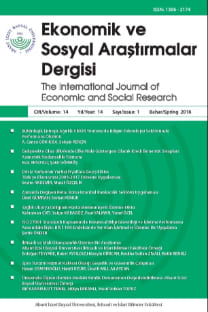İLAÇ FİRMA YÖNETİCİLERİNİN REKABET STRATEJİLERİ AÇISINDAN YÖNETSEL YETKİNLİKLERİNİ ETKİLEYEN FAKTÖRLER
Türkiye ilaç sektörü, ulusal ve uluslararası rekabetin yoğun yaşandığı, stratejik açıdan oldukça önemli bir sektör konumundadır. Buna rağmen Türkiye ilaç sektörü henüz dünya pazarında yeterli rekabet gücüne henüz ulaşamamıştır. Firma performansını arttırabilmek ve uzun dönemde bunu devam ettirebilmek, stratejik rekabet araçlarının kullanılmasını kaçınılmaz hale getirmiştir. Bu çalışmanın amacı; ilaç firma yöneticilerinin, rekabet stratejilerinin oluşturulmasına temel teşkil eden faaliyetleri (beş güç analizi ve değer zinciri analizi) içeren Porter (1980) modelini firmalarında hangi yetkinlik düzeyinde uyguladıklarını ve söz konusu yetkinlik düzeyleri üzerinde etkili olan değişkenleri tespit etmektir.
Bu amaçla yürütülen araştırmada 453 ilaç firması yöneticiye ulaşılmıştır. Toplanan verilerin analizi için IBM SPSS Statistics 20 programından yararlanılmıştır. Verilere ait tanımlayıcı istatistikler verilmiştir. Rekabet stratejileri açısından yönetsel yetkinlik durumları incelendiğinde; ilaç firma yöneticilerin %54,1’ inin yetkin olduğu ve %45,9’ unun yetkin olmadığı görülmüştür. Yönetsel yetkinlik düzeylerinde “Cinsiyet”, “Firmalarının İhracat Yapma Durumu”, “Yaş”, “Eğitim Durumu”, “Firmadaki pozisyon”, “Firma Ticaret Unvanı” ve “Firma Yaşı” değişkenlerinin etkili oldukları tespit edilmiştir (p
Anahtar Kelimeler:
Yönetsel Yetkinlik, , Stratejik Yönetim, İşletme Yönetimi, Michael Porter
___
- BARBER, C.S. ve TIETJE, B.C. (2004), “Competency Requirements for Managerial Development in Manufacturing, Assembly and/or Material Processing Functions”, Journal of Management Development, ss.596-607.
- BARNEY, J. B. (1991), “Firm Resources and Sustained Competitive Advantage”, Journal of Management, Vol. 17 No. 1, ss. 203-227.
- BARNEY, J. B. (1995), “The Resource-Based View: Origins and Implications”, Handbook of Strategic Management, ss.124-188.
- BARNEY, J.B. (1986), “Types of Competition and the Theory of Strategy: Toward an Integrative Framework”, The Academy of Management Review, Vol. 11, No. 4. ss. 791-800.
- BARNEY, J.B. (2002), “Strategic Management: From Informed Conversation to Academic Discipline”, Academy of Management Executive, 16(2): 53-57.
- BOYATZIS, R.E. (1982). “The Competent Manager: A Model for Effective Performance”, John Wiley & Sons, New York.
- BOYATZIS, R.E. (2008), “Competencies in The 21st Century”, Journal of Management Development, January.
- BOYATZIS, R.E., GOLEMAN, D. ve RHEE, K. (2000), “Clustering Competence in Emotional Intelligence Insights for the Emotional Competence Inventory”, Jossey-Bass, San Francisco.
- CHANDLER, A.D. Jr. (1962), “Strategy and Structure: Chapters in the History of Industrial Enterprise”, MIT Press, Cambridge, MA.
- DAY, G.S. ve WENSLEY, R. (1988), “Assessing Advantage: A Framework for Diagnosing Competitive Superiority”, Journal of Marketing, ss.1-20.
- GERSIL, A. (2006), “Stratejik Maliyet Yönetimi Kapsamında Mamul Yaşam Seyri Maliyet Yönteminin Analizi ve Bir İşletme Uygulaması”, Doktora Tezi, Ankara Üniversitesi Sosyal Bilimler Enstitüsü, Ankara.
- HELLRIEGEL, D., JACKSON, S.E., SLOCUM, J., STAUDE, G., AMOS, T., KLOPPER, H.P., LOUW, L. ve OOSTHUİZEN, T. (2008), “Management”, Second Edition, Oxford University Press, Oxford.
- HENDERSON, R. (2000), “Compensation Management in Knowledge Based World”, Oxford University Press, Oxford.
- HILL, C.W.L.ve JONES, G.R. (2009), “Essentials of Strategic Management”, South-Western Cengage Learning, Second Edition, USA.
- KAPLAN, R.S. ve NORTON, D.P. (2000), “Strategy-Focused Organisation. How Balanced Scorecard Companies Thrive in the New Business Environment”, Boston, MA: Harvard Business School Press.
- KARASAR, N. (2012), “Bilimsel Araştırma Yöntemi”, Nobel Yayınları, Ankara.
- LAKSHMINARAYANAN, S., PAI, Y. ve RAMAPRASAD, B. (2016), “Competency Need Assessment: A Gap Analytic Approach”, Industrial and Commercial Training, Vol. 48 No. 8, ss.423-430.
- LUCIA, A.D. ve LEBSINGER, R. (1999), “The Art and Science of Competencey Models: Pinpointing Critical Success Factors in Organizations”, Jassey-Bass Pfeifer, San Francisco.
- Mc CLELLAND, D.C. (1973), “Testing for Competence Rather Than Intelligence”, American Psychologist, Vol. 28 no. 1.
- PEARCE, J.A. ve ROBINSON, R.B. (2011), “Strategic Management: Formulation, Implementation and Control”, McGraw Hill, New York.
- PERRENOUD, P. (1999), “The Key to Social Fields: Essay on The Competencies of an Autonomous Actor, A Sociological Perspective”, DeSeCo Expert Report, Federal Statistical Office, Neuchâtel-Swiss.
- PORTER, M. E. (1980), “Competitive Strategy: Techniques for Analyzing Industries and Competitors”, The Free Press, New York.
- PORTER, M. E. (1981), “The Contributions of Industrial Organization to Strategic Management”, Academy of Management Review, 6, ss. 609-620.
- PORTER, M. E. (1991), “Towards a Dynamic Theory of Strategy”, Strategic Management Journal, Vol. 12, ss. 95-117.
- PORTER, M.E. (1985), “Competitive Advantage. Creating and Sustaining Superior Performance”, The Free Press, New York.
- PORTER, M.E. (1996), “Strateji Nedir”, HBR’S 10 Must Reads, Strateji (Melis İNAN, Çev.) Optimist Kitap, İstanbul. (Kitabın yayın tarihi 2013).
- PORTER, M.E. (2008), “Stratejiyi Şekillendiren Beş Rekabet Kuvveti”, HBR’S 10 Must Reads, Strateji (Melis İNAN, Çev.), Optimist Kitap, İstanbul. (Kitabın yayın tarihi 2013).
- SPENCER, L.M. ve SPENCER, S.M. (1993), “Competence at Work: Models for Superior Performance”, John Wiley & Sons, New York.
- ÜLGEN, H. ve MİRZE, K. (2010), “İşletmelerde Stratejik Yönetim”, Literatür Yayınları, İstanbul.
- WERNERFELT, B. (1984), “A Resource-Based View of the Firm”, Strategic Management Journal, Vol. 5 No. 12, ss. 171-80.
- ISSN: 1306-2174
- Yayın Aralığı: Yılda 2 Sayı
- Başlangıç: 2005
- Yayıncı: Abant İzzet Baysal Üniversitesi İktisadi ve İdari Bilimler Fakültesi
Sayıdaki Diğer Makaleler
AZERBAYCAN’IN TÜRKİYE’YE PETROL İHRACATININ AZERBAYCAN’IN EKONOMİK BÜYÜMESİNE ETKİLERİ
DEMOKRAT PARTİ DÖNEMİ AFYON ÜRETİM VE TİCARETİ
ÇİN’İN KÜRESEL ENERJİ GÜVENLİĞİNDE KAZAKİSTAN’IN YERİ
İNOVASYONUN YENİ YÜZÜ: AÇIK YEŞİL İNOVASYON
AVRASYA JEOPOLİTİĞİNDE TÜRKİYE'NİN ENERJİ POLİTİKALARI: TANAP VE TÜRK AKIMI
MEVDUAT VE KATILIM BANKALARININ KREDİ TEKLİF VE TAHSİS SÜREÇLERİ AÇISINDAN KARŞILAŞTIRILMASI
Ahmet ŞİT, Haydar KARADAĞ, Mustafa ŞİT
EŞDEĞERLİK ÖLÇEĞİ SEÇİMİNE GÖRE YOKSULLUK GÖSTERGELERİNİN ANALİZİ: TÜRKİYE UYGULAMASI
